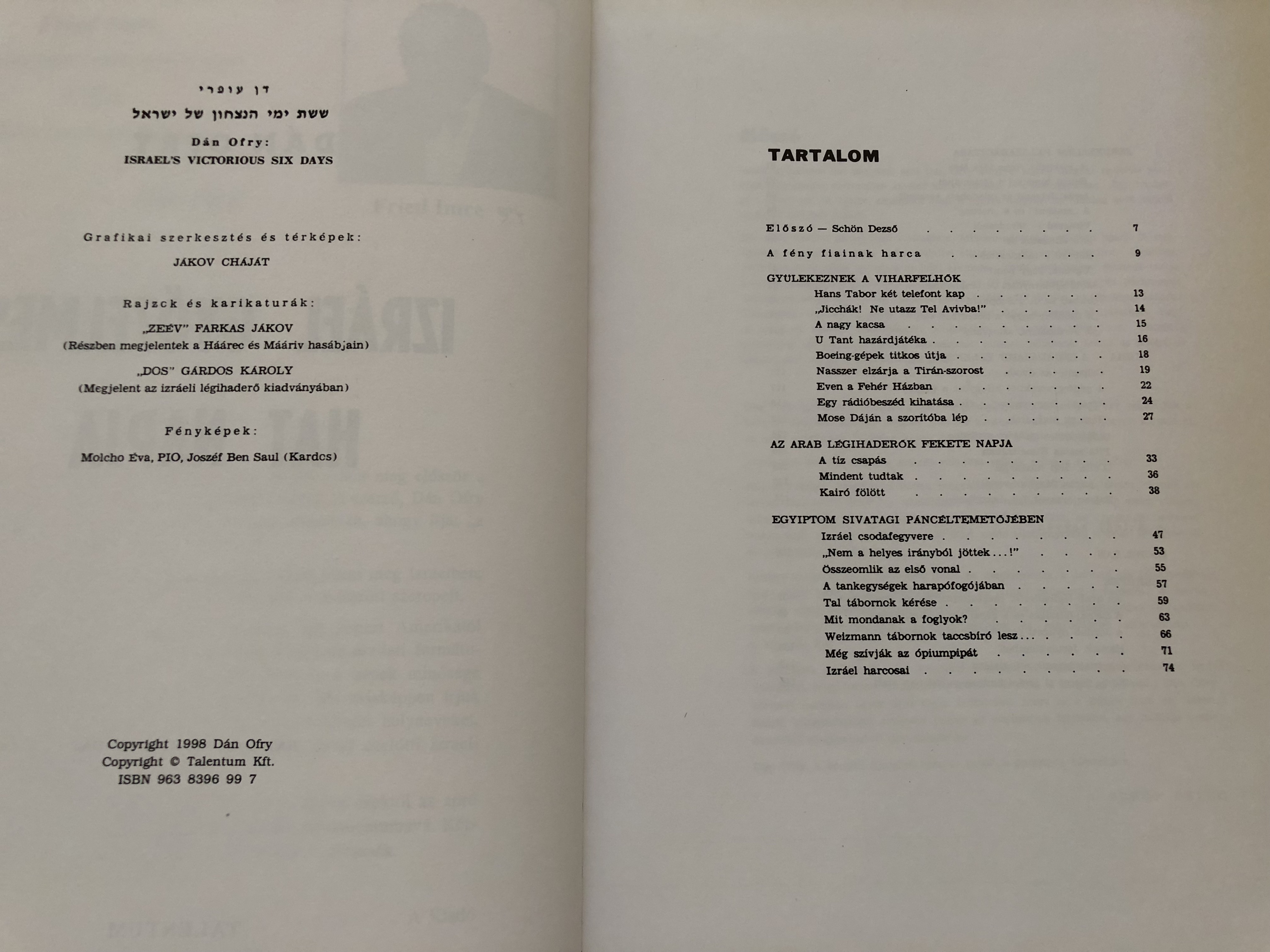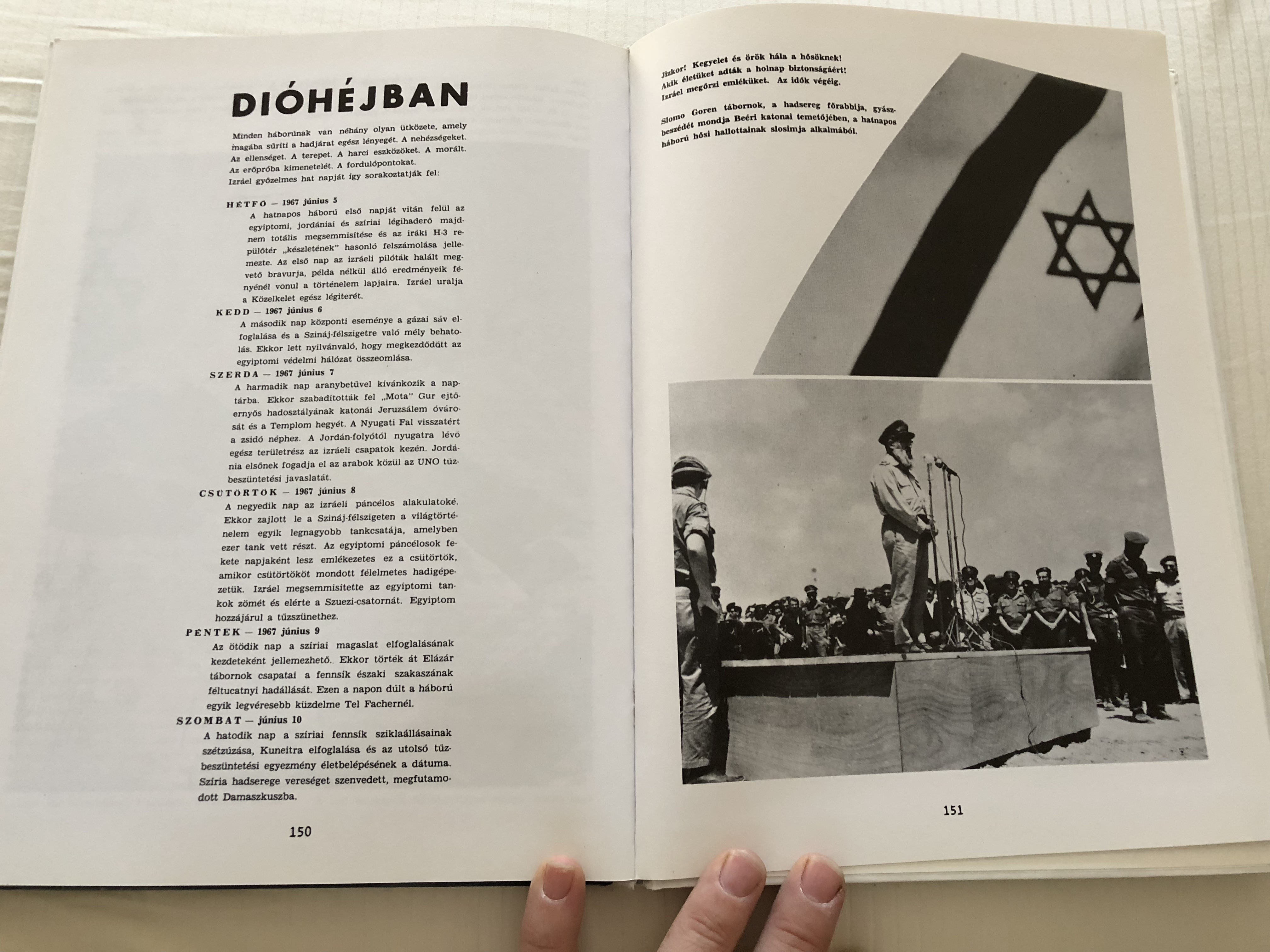Description
Izráel Győzelmes Hat Napja - Dán Ofry
Israel's Victorious Six Days (Hungarian & English Edition)
Overview / Áttekintés
Izráel Győzelmes Hat Napja (Israel's Victorious Six Days) by Dán Ofry is a profound and visually captivating book that delves into the historical significance of Israel's Six-Day War. Through rich illustrations by Farkas Jákov and Gárdos Károly, the book brings the events of this pivotal moment in history to life, offering readers both a narrative and artistic representation of Israel's victory in 1967.
Az Izráel Győzelmes Hat Napja Dán Ofry-tól egy mélyreható és vizuálisan lenyűgöző könyv, amely Izrael Hat Napos Háborújának történelmi jelentőségét tárja fel. A Farkas Jákov és Gárdos Károly gazdag illusztrációi életre keltik az 1967-es győzelem eseményeit, és narratívát valamint művészeti ábrázolást kínálnak Izrael győzelméről.
Product Features / Termékjellemzők
- Title / Cím: Izráel Győzelmes Hat Napja (Israel's Victorious Six Days)
- Author / Szerző: Dán Ofry
- Illustrators / Illusztrátorok: Farkas Jákov, Gárdos Károly
- Publisher / Kiadó: Aranymetszés Bt.
- Edition / Kiadás: Sixth (Reprint Edition) / Hatodik (reprint kiadás)
- Place of Publication / Kiadás helye: Budapest
- Publication Year / Kiadás éve: 1998
- ISBN: 9638396997
- Binding / Kötés: Hardcover / Kemény papírkötés
- Pages / Oldalszám: 151
- Language / Nyelv: Hungarian / English
- Dimensions / Méretek: Width: 22.00 cm, Height: 30.00 cm / Szélesség: 22.00 cm, Magasság: 30.00 cm
- Weight / Súly: 0.80 kg
Key Highlights / Főbb jellemzők
- Historical Significance / Történelmi jelentőség: Focuses on the 1967 Six-Day War, a pivotal moment in Israel's history and the broader Middle East conflict. / Az 1967-es Hat Napos Háborúra összpontosít, amely Izrael történelmének és a szélesebb közel-keleti konfliktusnak egyik kulcsfontosságú pillanata volt.
- Artistic Illustrations / Művészeti illusztrációk: Beautiful illustrations by renowned artists Farkas Jákov and Gárdos Károly bring historical events to life with vivid imagery. / Gyönyörű illusztrációk, amelyeket a neves művészek, Farkas Jákov és Gárdos Károly készítettek, élettel telítik a történelmi eseményeket élénk képekkel.
- Comprehensive Coverage / Átfogó bemutatás: The book covers military, strategic, political, and social perspectives, providing a holistic view of the conflict. / A könyv a katonai, stratégiai, politikai és társadalmi szempontokat öleli fel, átfogó képet adva a konfliktusról.
- Hungarian Language Edition / Magyar nyelvű kiadás: Written in Hungarian, this edition makes the story accessible to a Hungarian-speaking audience, enriching their understanding of this historical event. / Magyarul íródott, így ez a kiadás lehetővé teszi a történet megértését a magyarul beszélő közönség számára, gazdagítva ezzel a történelmi eseményekről való tudásukat.
Interesting Facts / Érdekes tények
- The Six-Day War of 1967 was a significant event in Israel's history, resulting in territorial gains and changing the dynamics of the Middle East. / Az 1967-es Hat Napos Háború Izrael történelmének egy jelentős eseménye volt, amely területi nyereséget eredményezett és megváltoztatta a Közel-Kelet dinamikáját.
- Izráel Győzelmes Hat Napja not only highlights military victories but also the strategic planning and leadership that contributed to Israel’s success in the war. / Az Izráel Győzelmes Hat Napja nemcsak a katonai győzelmeket emeli ki, hanem a stratégiai tervezést és vezetést is, amelyek hozzájárultak Izrael sikeréhez a háborúban.
- The sixth edition offers a reprint of this important work, making it available to a new generation of readers interested in understanding the complexities of the conflict. / A hatodik kiadás újranyomása ezen fontos munkának, lehetővé téve, hogy egy újabb olvasó generáció számára is elérhetővé váljon, akik érdeklődnek a konfliktus bonyolultságának megértése iránt.
Hashtags / Hashtagek
#SixDayWar #IsraelHistory #DánOfry #HungarianBooks #MiddleEastHistory #IsraelVictory #HungarianEdition #HistoricalBooks
#HatNaposHáború #IzraelTörténelem #DánOfry #MagyarKönyvek #KözelKeletTörténelem #IzraelGyőzelem #MagyarKiadás #TörténelmiKönyvek















































